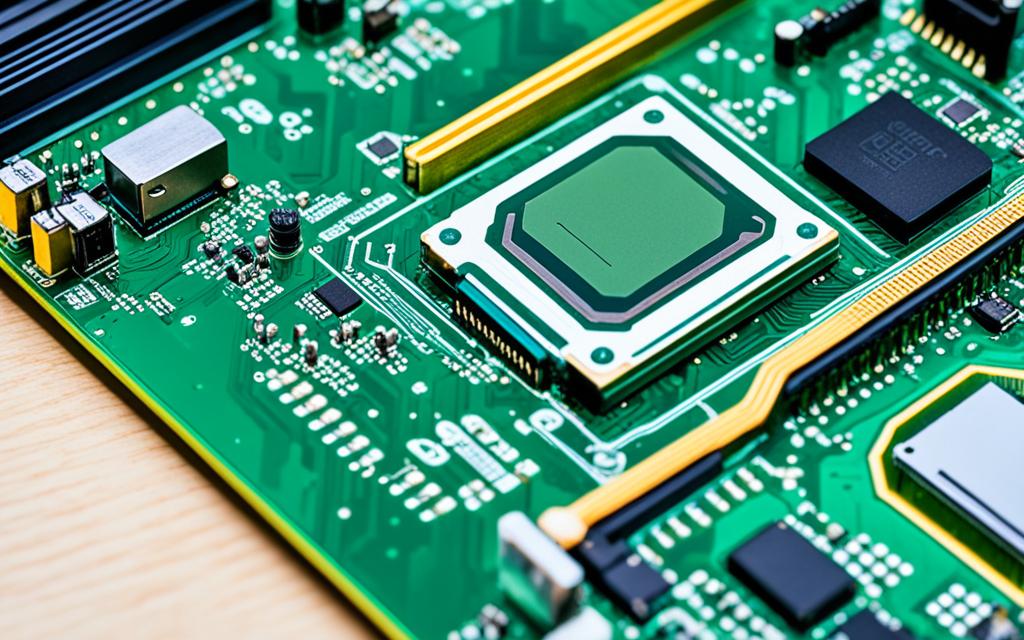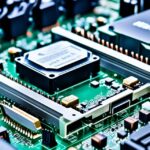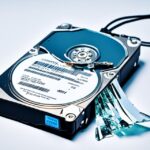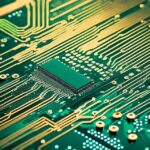Table of Contents
Formatting a hard drive through BIOS can be key to fixing major computer problems. Problems like boot failures or damaged operating systems often require it. Knowing how to format an HDD in BIOS helps with troubleshooting and setting up for a new OS installation. This guide will show you important steps and tips for formatting your hard drive the right way.
Key Takeaways
- Formatting an HDD in BIOS is vital for resolving boot issues.
- Regular backups should be made to secure important data before formatting.
- The command prompt method can be a sophisticated way to format your HDD.
- Advanced data recovery tools like Wondershare Recoverit can assist in retrieving lost data.
- Using the correct BIOS settings is crucial for successful hard drive formatting.
- EaseUS Partition Master is a user-friendly tool recommended for beginners.
- Learning how to format HDD in BIOS can empower users to manage their systems effectively.
Understanding the Need to Format an HDD
Formatting an HDD is crucial for different needs or situations. It sheds light on why this process is key for good system health and performance.
Reasons for Formatting
There are many reasons to format an HDD. For example, it clears up space by deleting unwanted files, resets the file system, and gets rid of infected files that threaten system safety1. People often need to format when their computer won’t start, keeps restarting, or when they need to change the operating system’s partition. Formatting gives a clean slate and makes it easier to reinstall Windows or switch file systems1.
Potential Risks
However, formatting HDDs comes with risks. The biggest one is losing all data on the drive, which can be permanent if not backed up. Fiddling with BIOS settings can also harm the system badly. It can lead to crashes, freezes, or a computer that won’t start1. So, it’s crucial to think it through and prepare before formatting. Using trusted data recovery software, like Stellar Data Recovery Professional, might retrieve lost data if needed.
Can You Format an HDD Directly in BIOS?
Trying to format an HDD through the BIOS faces some hurdles. This is because of BIOS limitations. Most folks think they can format their HDD right from the BIOS. However, this isn’t straightforward. Usually, you would boot from something like a USB or a CD/DVD. This contains the software needed to format the HDD2.
Knowing how to tweak BIOS settings is crucial. You generally use keys like F2, F1, F8, or the Del key to get into BIOS. When you’re there, you can set your computer to start from a USB or CD/DVD3. After setting this up, you reboot the computer. This lets you use the commands to format.
There’s a common misunderstanding about BIOS capabilities. Many think they can manage their HDD’s volumes directly in BIOS. But, BIOS usually doesn’t offer those options. It’s important to grasp the whole process to format successfully. This avoids any issues later on2.
Preparing to Format Your HDD
Getting ready to format your HDD properly is key. It helps to collect the right tools for formatting HDD and keeping your data safe. This makes a big difference in your formatting journey.
Gather Required Tools
Start by figuring out what tools you need for an easy process. You’ll need a bootable USB drive or an installation disc with your chosen operating system. EaseUS Partition Master is brilliant for formatting hard drives from BIOS and is chosen often by users4. Also, AOMEI Partition Assistant is liked by many for its simple BIOS formatting5. Getting these tools ready boosts your confidence and smooths the process.
Back Up Important Data
Think about backing up your data before formatting. It’s crucial to save important info on an external drive or cloud storage. This protects your data from being lost forever when you format. A lot of people like the quick and safe way of formatting from BIOS5. Losing data is a big risk, so it’s important to be safe.
How to Format an HDD in BIOS
To format a hard drive using BIOS, follow structured steps for success. Start by connecting a bootable USB or CD/DVD. Then, restart your machine. Press keys like F2, F1, F8, or Del to enter BIOS. This access is crucial for modifying the boot sequence. Selecting your bootable media as the first boot device is key to start the format3.
After your system boots from the chosen media, you’ll reach the installation setup. At this point, choose the option to format your hard drive. Users can decide to either delete partitions or format existing ones. It’s important to pick the right file system, like NTFS or FAT32, at this crucial step4.
This method offers the flexibility to efficiently manage drives, solving issues such as bootable partition problems or prepping a system for reuse. Remember, formatting from BIOS erases all data. So, it’s wise to back up important files before starting these format HDD BIOS steps.
| Step | Description |
|---|---|
| 1 | Connect bootable media (USB or CD/DVD). |
| 2 | Restart computer and enter BIOS settings. |
| 3 | Modify the boot sequence to prioritise the bootable media. |
| 4 | Boot from the media and select the formatting option. |
| 5 | Choose to delete partitions or format existing ones. |
| 6 | Select the correct file system during the process. |
Utilising Command Prompt for Disk Formatting
Formatting an HDD is easy using the Command Prompt. This approach shines when using Windows installation media. It offers a reliable option outside the usual graphical interfaces. With the right preparation, users access powerful commands for managing their disks.
Accessing Command Prompt via Installation Media
To start, boot up from the installation media. When the setup appears, go to the repair options. Choose Command Prompt in the advanced options thereafter. This method makes disk management smooth, using a command-line environment.
Executing Format Commands
In Command Prompt, you can use commands to format the HDD. The diskpart tool is handy for managing partitions. By typing diskpart then list disk, you identify all disks. Select your disk and use format FS=NTFS to format. This makes the process simple and adaptable to your needs.
| Command | Description |
|---|---|
| diskpart | Launches the Disk Partition tool for managing disks |
| list disk | Displays all connected disks for selection |
| select disk X | Selects the target disk for formatting, replacing X with the disk number |
| clean | Removes all partitions and data from the selected disk |
| create partition primary | Creates a new primary partition on the selected disk |
| format fs=ntfs | Formats the partition to NTFS file system |
Using the command line boosts efficiency for advanced users. It lets them optimise HDD formatting, including scheduling tasks. Knowing how to use CMD for formatting adds to your disk management skills. It is useful in automated environments. Users should learn these commands to improve their system’s performance and reliability678.
Alternative Methods of Formatting the HDD
There are many other ways to format hard drives apart from the usual methods. Using third-party HDD formatting tools can make the process better. It makes things quicker and smoother.
Using Third-Party Software
Using tools like EaseUS Partition Master gives you more formatting options. This tool doesn’t just make the process easier but also helps create bootable media. It’s a good choice when you find the normal ways too tricky. EaseUS Partition Master is shown to be faster and simpler than the Windows 10 Media Creation Tool for hard drive formatting4.
Understanding WinPE Bootable Media
WinPE makes HDD formatting easier by offering a light operating system. This system lets you use Windows-based tools before your computer starts. It’s really useful for tricky formatting jobs, especially if your hard drive has problems. Many find formatting with WinPE better when usual ways don’t work3.
Before formatting, it’s smart to check your hard drive’s health. Using programs like HD Sentinel can stop you from losing data. It ensures your hard drive is ready for formatting9.
Recovering Data from a Formatted HDD
After formatting a hard drive, you might lose important data. But, you can often get it back under the right conditions. Formatting doesn’t really delete the data on the disk; it only removes the data from address tables. This means recovery is possible10. Many tools can help you get back your files, especially if the disk hasn’t been overwritten. Using trusted software like DiskInternals Partition Recovery™ can help. It supports recovery from different file systems, including NTFS and FAT10.
It’s crucial to act quickly after formatting your drive. The more you use the drive, the less likely you can get your files back. Some tools, like iCare Data Recovery Free and Tenorshare 4DDiG, are great at recovering data from formatted drives. They can handle many types of data311. But remember, it’s usually easier to recover data from HDDs than SSDs10
For the best chance of getting your data back, use recovery tools right away. Also, don’t use the drive you’re trying to recover from. Since every recovery case is different, trying different methods might work best.
Conclusion
HDD formatting is complex and demands a deep understanding to dodge risks. Before you start, it’s crucial to back up crucial files12. Despite the challenge, following a step-by-step guide ensures successful disk formatting12.
Employing BIOS for formatting requires readiness and knowledge of the available options, like the Command Prompt or software such as Wondershare Recoverit. This tool is popular, with over 5 million downloads, and helps with recovering files after formatting13. Knowing about different file systems, especially NTFS for system partitions, makes your drive more reliable and secure12.
This guide highlights the key steps for formatting a HDD efficiently. Through well-informed choices and alternative methods, users can confidently manage their data. This ensures their system’s integrity and functionality14. For more help, visit the installation guide at this link.
FAQ
What is the purpose of formatting an HDD in BIOS?
Formatting an HDD in BIOS helps solve problems like boot failures and corrupted systems. It’s done to make the drive ready for new system installation. This process is good for making your computer start fresh.
What risks are involved in formatting an HDD?
When you format an HDD, all data on it will be lost. Before you format, it’s very important to save your files elsewhere. This ensures you don’t lose your important information.
Can I format my HDD directly from BIOS?
No, you cannot format an HDD directly from BIOS. You need bootable media like a USB or CD to format properly.
What tools do I need to format an HDD?
You need a bootable USB or an installation disc for formatting. Also, don’t forget to backup your data to avoid losing it.
How do I back up my important data before formatting my HDD?
To back up data, use an external hard drive, USB flash drive, or cloud services. It’s a crucial step to protect your files during formatting.
What are the steps to format an HDD in BIOS?
First, plug in your bootable media and restart your PC. Access BIOS with F2, DEL, or ESC. Set your computer to boot from the USB or DVD.
Then, follow the on-screen instructions to format your drive. Choose the file system format carefully during this process.
How can I use Command Prompt for formatting my HDD?
Boot with your installation media and go to repair options. Choose Command Prompt and use commands like ‘diskpart’ and ‘format fs=ntfs’ to format your drive.
What third-party software can help with formatting my HDD?
EaseUS Partition Master can make formatting easier. WinPE is also good for running formatting tools in a simple environment.
Is it possible to recover data after formatting an HDD?
Yes, data recovery is possible after formatting with tools like Wondershare Recoverit. But, use the formatted drive minimally to increase recovery chances.
Source Links
- https://www.stellarinfo.com/article/format-hard-drive-from-bios.php – Methods to Format a Hard Drive from BIOS
- https://www.partitionwizard.com/news/wipe-or-erase-a-hard-drive-from-bios.html – Wipe or Erase a Hard Drive from BIOS [2 Effective Methods] – MiniTool Partition Wizard
- https://www.icare-recovery.com/howto/bios-to-format-hard-drive.html – BIOS to Format Hard Drive – How to Format HDD from BIOS
- https://www.easeus.com/partition-master/format-hard-drive-from-bios-windows-10.html – How to Format Hard Drive from BIOS Windows 10
- https://www.diskpart.com/articles/how-to-format-hard-drive-from-bios-without-cd-0310.html – Stepwise Guide on How to Format Hard Drive from BIOS without CD/DVD
- https://learn.microsoft.com/en-us/windows-server/administration/windows-commands/diskpart-scripts-and-examples – diskpart scripts and examples
- https://4ddig.tenorshare.com/hard-drive/how-to-format-c-drive.html – How to Format C Drive in Windows 10/11? Top 4 Ways
- https://discussions.apple.com/thread/2756456 – Disk commands – Apple Community
- https://ecogreenitrecycling.co.uk/how-to-format-hard-drive/ – How To Format A Hard Drive From BIOS | Step By Step Guide
- https://www.diskinternals.com/partition-recovery/recover-data-from-formatted-hard-drive/ – How to recover data from a formatted hard drive
- https://4ddig.tenorshare.com/hard-drive/how-to-format-a-hard-drive-from-bios.html – 【2023 Update】2 Ways to Format a Hard Drive from BIOS Windows 10
- https://www.doyourdata.com/erase-data/wipe-hard-drive-from-bios.html – How to Wipe Hard Drive in BIOS Mode?
- https://recoverit.wondershare.com/format-harddrive/wipe-hard-drive-from-bios.html – Secure Ways to Wipe or Erase a Hard Drive from BIOS
- https://www.diskgenius.com/how-to/reformat-hard-drive.php – How to Reformat Hard Drive in Windows 10/8/7?








